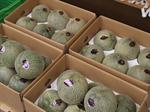Watermelons and Cantaloupe
 Melons are very large fast growing, and potentially highly productive vines. You can grow them on a trellis or let them spread over the ground. One plant can spread metres in diameter.
Melons are very large fast growing, and potentially highly productive vines. You can grow them on a trellis or let them spread over the ground. One plant can spread metres in diameter.
There are many different types, including cantaloupes and watermelons; and most need about 3 continuous months of warm weather to produce fruit.
The fruits can be quite variable, especially the heirloom varieties. Watermelon flesh may be the common red colour, but it can also be pink, white, lemon, and even apricot or orange! The outside skins also differ greatly and these may be plain green, striped or even yellow. The fruits can be weigh as little as 2kg, or as much as 14kg. Cantaloupes too come in a variety of shapes and colours ranging from round to banana-shaped, and the usual orange to lemon or green flesh. You can buy seed varieties that will grow and mature even in colder climates.
Examples of the types of heritage or heirloom varieties you can buy
Cantaloupes or Rock Melons (Cucumis melo)
‘Ananas’: yellow flesh, a very old and rare variety (harvest in 75-90 days).
‘Honey Dew Green’: green flesh variety (harvest in 100-120 days).
‘Honey Dew Orange’: the typical orange flesh variety (harvest in 100-120 days).
‘Honey Rock’: a typical orange flesh variety (harvest in 75-90 days).
‘Petit Gris De Rennes’: a very old variety going back some 400 years, perfect for cooler climates (90-100 days to harvest).
‘Top Mark’: green juicy flesh, a hardy and disease resistant variety (harvest in 80–90 days).
Musk melons (similar to cantaloupes in appearance but with a smoother skin)
‘Casaba Golden Beauty’: creamy flesh and golden skin (harvest in 100–110 days).
Watermelons
‘Black Diamond’: bright red flesh and stunning dark green skin (harvest in 85 days).
‘Sugar Baby’: a very dark green, small watermelon with great juicy flesh - this one is suited to cool climates as it is a miniature and early maturing variety (harvest in 70 days).
‘Cream of Saskatchewan’ – a very tasty white fleshed variety, skin tends to split at maturity but well worth the effort (harvest in 70 days).
Growing Conditions
Melons prefer hot, dry conditions. They are very frost-tender. They are suitable for warm seasons in temperate climates, but can be grown for more extended periods in warmer areas.
Cultural Practices
Melons are best grown in well-drained, preferably sandy soils. They respond well to frequent feeding. A pH range of 6.5 to 7 is preferred and the soil must be moisture retentive to grow good juicy crops. If your soils are acidic then add dolomite or garden lime. These plants love calcium so if your soils are within the right pH range then use gypsum instead as a source of calcium.
In cooler areas plant them in a north facing garden bed so you optimise the amount of sun. Melons need lots of water during plant establishment (the root zone should never dry out) and during fruit set, but not during fruit ripening.
How to Plant Melons
Seed should be planted 3-5cm deep in spring, after the danger of frosts has passed and the days are warm. In cool areas it is best to sow the seed in pots under cover or indoors around October and plant out in about mid-November. In warmer areas they can be sown directly in early spring. Planting distance will depend on the variety. Six plants will feed the average family.
Problems with Melons
Fruit may not set because of pollination problems. Bee-attracting companion plants can be useful, but they may also need hand pollinating. Crop rotation is important to prevent disease build-up in your garden beds.
Pest and Disease Problems of Melons
- Aphids - hose off with water or soap sprays like ‘Natrasoap’.
- Cutworm - these pests love the young stems of seedlings, use cardboard collars around seedlings to a depth of around 1cm or so.
- Leafhoppers - spray with a natural oil based product such as ‘eco-oil’.
- Mites - hose off or use ‘eco-oil’ or ‘Natrasoap’ to smother them.
- White fly - hang glue traps.
- Powdery mildew - spray with a product like ‘eco-fungicide’.
- Anthracnose - a 4-year crop rotation is important.
Harvesting Melons
Melons ripen at different rates according to the variety. Some have a short season, others a long season. In cooler areas it is unlikely that you will be harvesting before the end of February. When ripe, fruit will pull away from the stem easily.
You may also be interested in....